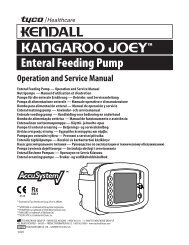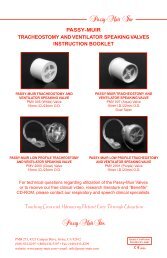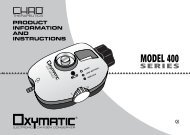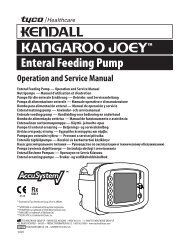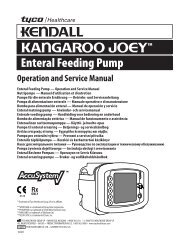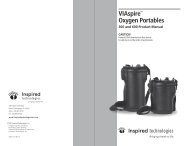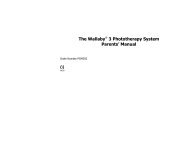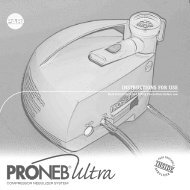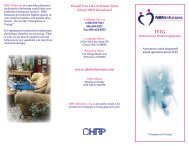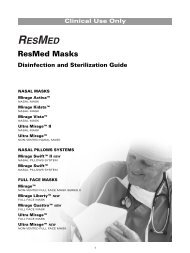34807 c-series tango user guide usa english-spanish ... - NBN Group
34807 c-series tango user guide usa english-spanish ... - NBN Group
34807 c-series tango user guide usa english-spanish ... - NBN Group
Create successful ePaper yourself
Turn your PDF publications into a flip-book with our unique Google optimized e-Paper software.
C-Series Tango TM<br />
User Guide<br />
1. Intended Use<br />
The Tango CPAP system is indicated for the treatment of obstructive sleep apnea (OSA) in patients<br />
weighing more than 66 lb (30 kg). It is intended for use at home.<br />
WARNING<br />
This device is intended for use in the USA only.<br />
CAUTION<br />
Federal law restricts this device to sale by or on the order of a physician.<br />
2. Contraindications<br />
Positive airway pressure therapy may be contraindicated in some patients with the following preexisting<br />
conditions:<br />
• severe bullous lung disease<br />
• pneumothorax<br />
• pathologically low blood pressure<br />
• dehydration<br />
• cerebrospinal fluid leak, recent cranial surgery or trauma.<br />
3. Adverse Effects<br />
Patients should report unusual chest pain, severe headache or increased breathlessness to their<br />
prescribing physician. An acute upper respiratory tract infection may require temporary<br />
discontinuation of treatment.<br />
The following side effects may arise during the course of therapy with the Tango:<br />
• drying of the nose, mouth or throat<br />
• nosebleed<br />
• bloating<br />
• ear or sinus discomfort<br />
• eye irritation<br />
• skin rashes.<br />
5. The Tango Interface<br />
Standby mode<br />
Ramp<br />
Altitude<br />
Power indicator<br />
Run hours<br />
Humidifier<br />
6. Setting up the Tango<br />
Heating<br />
indicator<br />
When the Tango is powered, the power indicator is lit and the run hours are<br />
displayed on the LCD. All changes to altitude and ramp settings are made in<br />
standby mode.<br />
Setting a ramp time enables therapy to start at a low pressure and build up<br />
to full pressure during the ramp time (see “Set ramp time”).<br />
Changes in altitude affect the pressure delivered by the Tango. The altitude<br />
feature compensates for pressure changes related to changes in altitude<br />
(see “Set altitude”).<br />
Run hours are displayed when the Tango is in standby mode.<br />
The humidifer buttons are used when using the C-Series Heated Humidifier<br />
and when setting the altitude. The heating indicator lights when the<br />
humidifier is on.<br />
CAUTION<br />
• Be careful to place the device where it cannot be bumped, and where no one will trip over<br />
the power cord.<br />
• If you put the device on the floor, make sure the area is free from dust and clear of<br />
bedding, clothes or other objects that could block the air inlet.<br />
• Make sure the area around the device is dry and clean.<br />
WARNING<br />
• Make sure the power cord and plug are in good condition and the equipment is not<br />
damaged.<br />
• Only ResMed air tubing should be used with the device. A different type of air tubing may<br />
alter the pressure you actually receive and reduce the effectiveness of your treatment.<br />
• Blocking the hose and/or air inlet of the device while in operation could lead to<br />
overheating of the device.<br />
8. Cleaning and Maintenance<br />
WARNING<br />
Beware of electric shock. Do not immerse the flow generator or power cord in water. Always<br />
unplug the flow generator before cleaning and make sure it is dry before reconnecting.<br />
CAUTION<br />
• Do not hang the air tubing in direct sunlight as it may harden over time and eventually<br />
crack.<br />
• Do not use bleach, chlorine, alcohol, or aromatic-based solutions, moisturizing or<br />
antibacterial soaps or scented oils to clean the air tubing or the Tango. These solutions<br />
may cause hardening and reduce the life of the product.<br />
Daily<br />
Disconnect the air tubing and hang it in a clean, dry place until next use.<br />
Weekly<br />
1. Remove the air tubing and wash it in warm water and mild detergent. Rinse thoroughly, hang<br />
and allow to dry.<br />
2. Before next use, reassemble the mask and headgear.<br />
3. Reconnect the air tubing.<br />
Monthly<br />
• Clean the exterior of the Tango with a damp cloth.<br />
• Check the air filter for holes and blockage by dirt. Replace it every six months, or more often in a<br />
dusty environment.<br />
For information on cleaning your mask or humidifier, refer to the manual supplied with your mask or<br />
humidifier.<br />
9. Changing the Air Filter<br />
CAUTION<br />
Do not wash the air filter.<br />
Air inlet<br />
Air filter<br />
1. With the power cord and air tubing disconnected, turn the Tango upside down so the air inlet is<br />
facing you. The air filter is inside the air inlet.<br />
2. Pull the old air filter out of the air inlet.<br />
3. Put the new air filter into the air inlet in the direction shown by the arrow, with the blue side<br />
facing towards you.<br />
13. General Warnings and Cautions<br />
A warning alerts you to possible injury.<br />
• Read the entire <strong>guide</strong> before using the Tango.<br />
• The advice in this <strong>guide</strong> should not supersede instructions given by the prescribing physician.<br />
• The Tango should only be used with masks (and connectors*) recommended by ResMed, or by a<br />
physician or respiratory therapist. A mask should not be used unless the Tango is turned on and<br />
operating properly. The vent hole or holes associated with the mask should never be blocked.<br />
Explanation: The Tango is intended for use with special masks (or connectors*) with vent holes<br />
allowing a continuous flow of air out of the mask.<br />
• When the device is turned on and functioning properly, new air from the device flushes the<br />
exhaled air out through the mask vent holes. If the device is not operating, insufficient fresh air is<br />
provided through the mask, and the exhaled air may be rebreathed. Rebreathing exhaled air for<br />
longer than several minutes can sometimes lead to suffocation. If there is a power failure or the<br />
device machine malfunctions, remove the mask.<br />
• The Tango can be set to deliver pressures up to 20 cm H 2 O. In the unlikely event of certain fault<br />
conditions, pressures up to 30 cm H 2 O are possible.<br />
• If oxygen is used with this device, the oxygen flow must be turned off when the device is not<br />
operating. If oxygen has been left on while the device is not operating, disconnect the oxygen<br />
and wait 30 minutes before turning on the flow generator again.<br />
Explanation: When the CPAP device is not in operation and the oxygen flow is left on, oxygen<br />
delivered into the air delivery tubing may accumulate within the CPAP machine enclosure and<br />
create a risk of fire.<br />
• Oxygen supports combustion. Do not use oxygen while you are smoking or in the presence of an<br />
open flame.<br />
• Always ensure air is flowing from the device before turning on the oxygen supply.<br />
• Always turn the oxygen supply off before stopping the airflow from the device.<br />
Note: At a fixed rate of supplemental oxygen flow, the inhaled oxygen concentration will vary,<br />
depending on where the oxygen is introduced, pressure settings, patient breathing pattern, mask<br />
selection and leak rate.<br />
• Do not use the Tango if there are obvious external defects or unexplained changes in<br />
performance.<br />
• Do not open the Tango case. There are no <strong>user</strong> serviceable parts inside. Repairs and internal<br />
servicing should only be performed by an authorized service agent.<br />
A caution explains special measures for safe and effective use of the device.<br />
• At low pressures, the flow through the exhalation ports of your mask may not clear all exhaled<br />
gas from the tubing. Some rebreathing may occur.<br />
• The airflow for breathing produced by this device can be as much as 11°F (6°C) higher than the<br />
temperature of the room. Be careful if the room temperature is warmer than 90°F (32°C).<br />
* Ports may be incorporated into the mask or in connectors that are near the mask.<br />
4. Parts of the Tango<br />
Your Tango comprises:<br />
• C-Series Tango flow generator (shown below)<br />
• Power cord<br />
• 6’6” (2 m) air tubing.<br />
1<br />
2<br />
Signal cable socket (humidifier<br />
use only)<br />
Power cord socket<br />
Masks<br />
The ResMed mask systems recommended for use with the Tango are:<br />
• Mirage TM Full Face Mask Series II • Meridian TM Nasal Mask<br />
• Ultra Mirage TM Full Face Mask • Mirage Nasal Mask<br />
• Mirage Swift TM Nasal • Mirage Activa TM Nasal Mask<br />
Pillows System<br />
• Mirage Vista TM Nasal Mask<br />
• Papillon TM Nasal Mask • Ultra Mirage TM Nasal Mask<br />
• Silent Papillon TM Nasal Mask<br />
For information on using masks, see your mask manual.<br />
1<br />
2<br />
3<br />
4<br />
Humidifiers<br />
For information on using the C-Series Heated Humidifier or the ResMed Passover, see your<br />
humidifier manual.<br />
3<br />
4<br />
Air outlet<br />
Air inlet (contains air filter)<br />
ResMed Ltd (Manufacturer) 1 Elizabeth MacArthur Drive Bella Vista NSW 2153 Australia • ResMed Corp (US Designated Agent) 14040 Danielson<br />
Street Poway CA 92064-6857 USA • ResMed (UK) Ltd (EU Authorized Representative) 65 Milton Park Abingdon Oxfordshire OX14 4RX UK •<br />
ResMed Offices Australia, Austria, Brazil, Finland, France, Germany, Hong Kong, Japan, Malaysia, Netherlands, New Zealand, Singapore, Spain,<br />
Sweden, Switzerland, UK, USA (see www.resmed.com for contact details).<br />
Protected by patents: US 4944310, US 5199424, US 5522382, US 6705315. Patents and designs pending.<br />
Tango, Mirage, Mirage Activa, Mirage Vista, Ultra Mirage, Mirage Swift, and Meridian are trademarks of ResMed Ltd. Mirage, Mirage Activa, Mirage<br />
Vista, Ultra Mirage, Mirage Swift and Meridian are registered in US Patent and Trademark Office. Papillon and Silent Papillon are trademarks of MAP<br />
Medizin-Technologie GmbH.<br />
©2006 ResMed Ltd. <strong>34807</strong>/1 06 06<br />
Global leaders in sleep and respiratory medicine<br />
www.resmed.com<br />
1 Connect power cord to the rear of the Tango.<br />
2 Plug the other end into a power outlet.<br />
3 Connect air tubing to air outlet of Tango.<br />
4 Connect assembled mask system to free end of air tubing.<br />
7. Using the Tango<br />
Start therapy<br />
Stop therapy<br />
Set ramp time<br />
Set altitude<br />
1<br />
3<br />
Press when the Tango is in standby mode. A circulating dash symbol<br />
displays on the LCD.<br />
If ramp is set, the ramp time displays on the LCD. When ramping is<br />
finished, therapy continues at the prescribed pressure.<br />
If no ramp is set, therapy starts immediately at the prescribed pressure.<br />
Press .<br />
1. Repeatedly press until the LCD displays the desired time.<br />
2. Press to accept changes and start therapy. (The Tango returns to<br />
standby mode after 5 seconds if no button is pressed.)<br />
The ramp settings are (in minutes):<br />
Off, 10, 20, 45.<br />
1. Hold down for 3 seconds until the current altitude setting is<br />
displayed.<br />
2. Press or to change the altitude setting.<br />
3. Press to accept changes and return to standby mode. (The Tango<br />
returns to standby mode after 10 seconds if no button is pressed.)<br />
The altitude settings are:<br />
1 (0–2000’/0–609 m),<br />
2 (2001–4000’/610–1219 m),<br />
3 (4001–6000’/ 1220–1828 m),<br />
4 (6001–8500’/ 1829–2591 m).<br />
2<br />
4<br />
10. Troubleshooting<br />
Problem Possible Cause Solution<br />
Tango won’t start Power cord not connected properly Check power cord.<br />
Faulty power outlet<br />
11. Technical Specifications<br />
12. Symbols Which Appear on the Tango<br />
Try another power outlet.<br />
No/low air flow Air tubing not connected properly Adjust air tubing connection.<br />
Treatment pressure seems either<br />
low or too high<br />
LCD displays an error message<br />
and treatment stops or can’t be<br />
started<br />
Operating pressure range<br />
Air tubing is blocked, pinched or<br />
punctured<br />
Altitude setting incorrect<br />
Problem with motor<br />
4 to 20 cm H 2 O<br />
Unblock or free air tubing. Check air<br />
tubing for punctures.<br />
Adjust altitude setting.<br />
Contact your supplier.<br />
Dimensions (L x W x H)<br />
8.5” x 7.4” x 4.5” (215 mm x 189 mm x 114 mm)<br />
Weight<br />
2.4 lb (1.1 kg)<br />
Power Supply<br />
Input range 110V, 60Hz, 20VA/10W (typical power consumption), 36VA/15W<br />
(maximum power consumption)<br />
Operating Temperature<br />
+41°F to +104°F (+5°C to +40°C)<br />
Operating Humidity<br />
10%–95% non-condensing<br />
Storage and Transport Temperature -4°F to +140°F (-20°C to +60°C)<br />
Storage and Transport Humidity 10%–95% non-condensing<br />
Atmospheric Pressure Range 1060 hPa (sea level) to 680 hPa (8500’/ 2591 m)<br />
Electromagnetic<br />
Compatibility<br />
Air Filter<br />
Product complies with all applicable electromagnetic compatibility requirements<br />
(EMC) according to IEC60601-1-2, for residential, commercial and light industry<br />
environments<br />
Two-layered, powder-bonded, polyester non-woven fiber<br />
Air Tubing Flexible plastic, 6’6” (2 m)<br />
Air Outlet The 0.87” (22 mm) conical air outlet complies with EN 1281-1<br />
IEC 60601-1 Classifications<br />
Class II (double insulation), Type CF<br />
The manufacturer reserves the right to change these specifications without notice.<br />
Attention. Consult<br />
accompanying documents<br />
Type CF equipment<br />
Canadian Standards Association<br />
Drip proof<br />
Class II equipment<br />
14. Servicing<br />
The Tango should be inspected by an authorized ResMed service center 5 years from the date of<br />
manufacture. Before this, the device is intended to provide safe and reliable operation if it is<br />
operated and maintained according to the instructions provided by ResMed. Warranty details are<br />
provided with the device at the time of original supply. As with all electrical devices, if any<br />
irregularity becomes apparent, you should have the device inspected by an authorized ResMed<br />
service center.<br />
15. Limited Warranty<br />
ResMed warrants that your ResMed product shall be free from defects in material and workmanship for the<br />
period specified below from the date of purchase by the initial consumer. This warranty is not transferable.<br />
Product<br />
Warranty Period<br />
ResMed humidifiers, ResControl, ResLink, ResTraxx<br />
1 Year<br />
ResMed flow generators<br />
2 Years<br />
Accessories, water chambers and mask systems (including mask frame, cushion, headgear and tubing). 90 Days<br />
Excludes single-use devices.<br />
Note: Some models are not available in all regions.<br />
If the product fails under conditions of normal use, ResMed will repair or replace, at its option, the defective<br />
product or any of its components. This Limited Warranty does not cover:<br />
a) any damage caused as a result of improper use, abuse, modification or alteration of the product;<br />
b) repairs carried out by any service organization that has not been expressly authorized by ResMed to perform<br />
such repairs;<br />
c) any damage or contamination due to cigarette, pipe, cigar or other smoke;<br />
d) any damage caused by water being spilled on or into a flow generator.<br />
Warranty is void on product sold, or resold, outside the region of original purchase. Warranty claims on defective<br />
product must be made by the initial consumer at the point of purchase.<br />
This warranty is in lieu of all other express or implied warranties, including any implied warranty of<br />
merchantability or fitness for a particular purpose. Some regions or states do not allow limitations on how long<br />
an implied warranty lasts, so the above limitation may not apply to you.<br />
ResMed shall not be responsible for any incidental or consequential damages claimed to have occurred as a<br />
result of the sale, installation or use of any ResMed product. Some regions or states do not allow the exclusion<br />
or limitation of incidental or consequential damages, so the above limitation may not apply to you. This warranty<br />
gives you specific legal rights, and you may also have other rights which vary from region to region.<br />
For further information on your warranty rights, contact your local ResMed dealer or ResMed office.
Tango TM C-Series<br />
Guía del usuario<br />
1. Uso indicado<br />
El sistema Tango CPAP es indicado para el tratamiento de la apnea obstructiva del sueño (AOS)<br />
en pacientes que pesen más de 30 kg (66 lb). Está diseñado para uso en el hogar.<br />
ADVERTENCIA<br />
Este dispositivo está diseñado para uso en los EE.UU. únicamente.<br />
PRECAUCIÓN<br />
La ley federal estipula que este aparato solamente puede ser vendido por un médico o por<br />
orden de éste.<br />
2. Contraindicaciones<br />
El tratamiento con presión positiva en las vías respiratorias puede estar contraindicado en algunos<br />
pacientes que presenten las siguientes afecciones previas:<br />
• enfermedad pulmonar bullosa grave<br />
• neumotórax<br />
• presión arterial patológicamente baja<br />
• deshidratación<br />
• fuga de líquido cefalorraquídeo, cirugía o traumatismo craneanos recientes.<br />
3. Efectos secundarios<br />
Los pacientes deben informar a su médico acerca de todo dolor torácico inusual, un dolor de cabeza<br />
severo o un aumento en su dificultad respiratoria. Una infección respiratoria alta aguda puede<br />
requerir la suspensión temporal del tratamiento.<br />
Los siguientes efectos secundarios pueden surgir durante el curso del tratamiento con el Tango:<br />
• sequedad de la nariz, boca o garganta<br />
• epistaxis<br />
• hinchazón por tragar aire<br />
• molestias sin<strong>usa</strong>les o del oído<br />
• irritación ocular<br />
• erupciones cutáneas<br />
5. La interfaz del Tango<br />
Modo de espera<br />
Rampa<br />
Altitud<br />
Indicador de<br />
alimentación<br />
Horas de<br />
funcionamiento<br />
Humidificador<br />
6. Configuración del Tango<br />
Indicador de<br />
calefacción<br />
Cuando se enciende el Tango, se enciende el indicador de alimentación y<br />
las horas de funcionamiento aparecen en el visor. Todos los cambios a las<br />
configuraciones de altitud y rampa se hacen en el modo de espera.<br />
Configurar un tiempo de rampa permite que el tratamiento comience con<br />
una presión baja y aumente hasta llegar a presión completa durante el<br />
tiempo de rampa (consulte “Configurar el tiempo de rampa”).<br />
Los cambios de altitud inciden en la presión suministrada por el Tango. La<br />
función de altitud compensa los cambios de presión relativos a cambios de<br />
altitud (consulte “Configurar altitud”).<br />
Las horas de funcionamiento aparecen cuando el Tango está en modo de<br />
espera.<br />
Los botones del humidificador se utilizan cuando se <strong>usa</strong> el humidificador<br />
térmico C-Series y al configurar la altitud. El indicador de calefacción se<br />
ilumina cuando está encendido el humidificador.<br />
PRECAUCIÓN<br />
• Tenga cuidado de no colocar el equipo en un lugar donde pueda ser golpeado o donde<br />
alguien pueda tropezar con el cable de corriente.<br />
• Si coloca el dispositivo en el piso, asegúrese de que el área esté libre de polvo y que no<br />
haya ropa, ropa de cama u otros objetos que pudieran obstruir la entrada de aire.<br />
• Asegúrese de que el área alrededor del generador de aire esté limpia y seca.<br />
ADVERTENCIA<br />
• Asegúrese de que el cable de alimentación y el enchufe estén en buenas condiciones y<br />
que el equipo no esté dañado.<br />
• Sólo debe <strong>usa</strong>rse un tubo de aire ResMed con el dispositivo. Un tubo de aire diferente<br />
podría modificar la presión que de hecho recibe, lo que reduciría la eficacia del<br />
tratamiento.<br />
• Bloquear la manguera y/o la entrada de aire del dispositivo mientras está en operación<br />
podría producir un sobrecalentamiento del dispositivo.<br />
8. Limpieza y mantenimiento<br />
ADVERTENCIA<br />
Peligro de electrocución. No sumerja en agua el generador de aire ni tampoco el cable de<br />
alimentación. Desconecte siempre el generador de aire antes de limpiarlo y asegúrese de que<br />
esté seco antes de volver a conectarlo.<br />
PRECAUCIÓN<br />
• No cuelgue el tubo de aire a la luz solar directa, ya que puede endurecerse y agrietarse<br />
con el tiempo.<br />
• No utilice blanqueadores, cloro, alcohol, soluciones aromáticas, jabones humectantes ni<br />
antibacterianos ni aceites aromatizados para limpiar el tubo de aire del Tango. Estas<br />
soluciones podrían endurecer el producto y reducir la vida útil del mismo.<br />
Diariamente<br />
Desconecte el tubo de aire y cuélguelo en un lugar limpio y seco hasta el próximo uso.<br />
Semanalmente<br />
1. Saque el tubo de aire y lávelo con agua tibia y detergente suave. Enjuague bien, cuélguelo y<br />
déjelo secar.<br />
2. Antes de <strong>usa</strong>rlo otra vez, vuelva a armar la mascarilla y el arnés para la cabeza.<br />
3. Vuelva a conectar el tubo de aire.<br />
Mensualmente<br />
• Limpie el exterior del Tango con un paño húmedo.<br />
• Verifique que el filtro de aire no tenga orificios ni esté obstruido por suciedad. Reemplácelo cada<br />
seis meses, o con mayor frecuencia si se <strong>usa</strong> en un entorno con mucho polvo.<br />
Para más información sobre la limpieza de la mascarilla o del humidificador, consulte el manual<br />
suministrado con la mascarilla o con el humidificador.<br />
9. Cambio del filtro de aire<br />
PRECAUCIÓN<br />
No lave el filtro de aire.<br />
Entrada de aire<br />
Filtro de aire<br />
1. Con el cable de alimentación y el tubo de aire desconectados, voltee el Tango de manera que la<br />
entrada de aire se orienta hacia usted. El filtro de aire está dentro de la entrada de aire..<br />
2. Saque el filtro de aire <strong>usa</strong>do de la entrada de aire.<br />
3. Coloque el filtro de aire nuevo en la entrada de aire en la dirección que indica la flecha, con el<br />
lado azul orientado hacia usted.<br />
13. Advertencias y precauciones generales<br />
Una advertencia alerta sobre la posibilidad de que se produzcan lesiones.<br />
• Lea por completo la guía antes de <strong>usa</strong>r el Tango.<br />
• Las indicaciones de esta guía no deben suplantar las instrucciones entregadas por el médico<br />
tratante.<br />
• El Tango sólo debe <strong>usa</strong>rse con mascarillas (y conectores*) recomendadas por ResMed, o por un<br />
médico o terapeuta respiratorio. No debe <strong>usa</strong>rse una mascarilla a menos que el Tango esté<br />
encendido y funcionando correctamente. Nunca se debe obstruir el o los orificios de ventilación<br />
asociados con la mascarilla.<br />
Explicación: El Tango está diseñado para ser <strong>usa</strong>do con mascarillas (o conectores*) especiales<br />
con orificios de ventilación que permiten un flujo continuo de aire desde la mascarilla.<br />
• Mientras el equipo esté encendido y funcionando correctamente, el aire fresco del dispositivo<br />
desplaza el aire espirado hacia fuera de la mascarilla a través de sus orificios de ventilación. Si el<br />
dispositivo no está funcionando, no se proporciona suficiente aire fresco por la mascarilla, y es<br />
posible que se vuelva a respirar aire exhalado. Volver a respirar aire exhalado durante varios<br />
minutos puede en ocasiones conducir a la asfixia. Si se produce una falla eléctrica o si falla el<br />
dispositivo, retire la mascarilla.<br />
• El Tango puede configurarse para suministrar presiones de hasta 20 cm H 2 O. En el caso poco<br />
probable de ciertas situaciones de fallas, es posible suministrar presiones de hasta 30 cm H 2 O.<br />
• Si se utiliza oxígeno con este equipo, el flujo del mismo deberá estar cerrado mientras el equipo<br />
no esté en funcionamiento. Si se deja activado el oxígeno mientras el dispositivo no está<br />
funcionando, desconecte el oxígeno y espere 30 minutos antes de volver a encender el<br />
generador de aire.<br />
Explicación: mientras el equipo CPAP no esté funcionando, si se deja abierto el flujo de oxígeno,<br />
el oxígeno suministrado al tubo de respiración podrá acumularse dentro del dispositivo CPAP,<br />
creando así un riesgo de incendio.<br />
• El oxígeno favorece la combustión. No utilice oxígeno mientras esté fumando ni en presencia de<br />
llamas expuestas.<br />
• Asegúrese siempre de que esté fluyendo aire desde el dispositivo antes de encender el<br />
suministro de oxígeno.<br />
• Siempre apague el suministro de oxígeno antes de detener el flujo de aire desde el equipo.<br />
Nota: A un determinado caudal de oxígeno suplementario, la concentración de oxígeno inhalado<br />
variará según dónde se introduzca el oxígeno, los parámetros de presión, el ritmo respiratorio del<br />
paciente, la selección de la mascarilla y el índice de fuga.<br />
• No utilice el Tango si presenta defectos externos obvios o si ocurren cambios inexplicados en su<br />
funcionamiento.<br />
• No abra la caja del Tango. No hay piezas dentro que el usuario pueda reparar. Las reparaciones y<br />
el mantenimiento interno deberán ser efectuados únicamente por un agente de servicio<br />
autorizado.<br />
Una precaución explica medidas especiales para el uso seguro y eficaz del dispositivo.<br />
• A bajas presiones, el flujo a través de los puertos de exhalación de la mascarilla puede no<br />
eliminar todos los gases exhalados del tubo. Puede darse cierto grado de reinspiración.<br />
• El flujo de aire generado por este dispositivo para la respiración puede llegar a estar hasta 11°F<br />
(6°C) por encima de la temperatura ambiente. Tenga cuidado si la temperatura ambiente es de<br />
más de 90°F (32°C).<br />
* Pueden integrarse puertos en la mascarilla o en los conectores próximos a la mascarilla.<br />
4. Piezas del Tango<br />
El Tango consta de:<br />
• Generador de aire Tango C-Series (aparece a continuación)<br />
• Cable de alimentación<br />
• Tubo de aire de 6 pies y 6 pulgadas (2 m).<br />
1<br />
2<br />
Mascarillas<br />
Enchufe de cable de señal<br />
(sólo para uso con<br />
humidificador)<br />
Enchufe de cable de<br />
alimentación<br />
1<br />
2<br />
3<br />
3<br />
4<br />
4<br />
Salida de aire<br />
Entrada de aire (contiene<br />
filtro de aire)<br />
Los sistemas de mascarillas ResMed recomendados para ser utilizados con el Tango son:<br />
• Mascarilla facial Mirage TM serie II • Mascarilla nasal Meridian TM<br />
• Mascarilla facial Ultra Mirage TM • Mascarilla nasal Mirage<br />
• Sistema de almohadillas • Mascarilla nasal Mirage Activa TM<br />
nasales Mirage Swift TM<br />
• Mascarilla nasal Mirage Vista TM<br />
• Mascarilla nasal Papillon TM • Mascarilla nasal Ultra Mirage TM<br />
• Mascarilla nasal Silent Papillon TM<br />
Para información sobre el uso de las mascarillas, consulte el manual de su mascarilla.<br />
Humidificadores<br />
Para más información sobre el uso del ResMed Passover o del humidificador térmico C-Series,<br />
consulte el manual de su humidificador.<br />
1 Conecte el cable de corriente a la parte trasera del Tango.<br />
2 Enchufe el otro extremo a una toma de corriente.<br />
3 Conecte el tubo de aire a la salida de aire del Tango.<br />
4 Conecte el sistema de mascarilla armado al extremo libre del tubo de aire.<br />
7. Uso del Tango<br />
1<br />
3<br />
Inicio del tratamiento<br />
Presione cuando el Tango esté en modo de espera. Aparece un<br />
símbolo de guion circulante en el visor.<br />
Si está configurada la rampa, aparece en el visor el tiempo de rampa.<br />
Cuando concluye la rampa, el tratamiento sigue con la presión prescrita.<br />
Si no se ha configurado la rampa, la terapia comienza de inmediato con la<br />
presión prescrita.<br />
Detención del<br />
tratamiento Presione .<br />
Configurar el tiempo de<br />
rampa 1. Presione varias veces hasta que en el visor aparezca el tiempo que<br />
desee.<br />
Configurar altitud<br />
2. Presione para aceptar los cambios y comenzar el tratamiento. (El<br />
Tango vuelve al modo de espera después de 5 segundos si no se<br />
presiona ningún botón).<br />
Las configuraciones de rampa son (en minutos):<br />
Apag, 10, 20, 45.<br />
1. Mantenga presionado durante 3 segundos hasta que aparezca la<br />
configuración de altitud actual.<br />
2. Para cambiar la configuración de altitud, presione o .<br />
3. Presione para aceptar los cambios y volver al modo de espera. (El<br />
Tango vuelve al modo de espera después de 10 segundos si no se<br />
presiona ningún botón).<br />
Las configuraciónes de altitud son:<br />
1 (0–2000 pies/0–609 m),<br />
2 (2001–4000 pies/610–1219 m),<br />
3 (4001–6000 pies/1220–1828 m),<br />
4 (6001–8500 pies/1829–2591 m).<br />
2<br />
4<br />
10. Solución de problemas<br />
Problema Ca<strong>usa</strong> posible Solución<br />
El Tango no se pone en marcha El cable de alimentación no está Revise el cable de alimentación.<br />
debidamente conectado.<br />
La toma de corriente está<br />
Pruebe otra toma de corriente.<br />
defectuosa.<br />
No hay flujo de aire o éste es<br />
muy bajo<br />
El tubo de aire no está debidamente Ajuste la conexión del tubo de aire.<br />
conectado.<br />
La presión de tratamiento parece<br />
ser demasiado baja o demasiado<br />
alta<br />
El visor muestra un mensaje de<br />
error y el tratamiento se detiene<br />
o no puede ponerse en marcha<br />
El tubo de aire está obstruido,<br />
torcido o roto.<br />
Configuración de altitud incorrecta.<br />
Problema con el motor<br />
11. Especificaciones técnicas<br />
12. Símbolos que aparecen en el Tango<br />
Desobstruya o despeje el tubo de aire.<br />
Verifique que el tubo de aire no esté<br />
perforado.<br />
Ajuste la configuración de altitud.<br />
Póngase en contacto con su<br />
proveedor.<br />
Rango de presión de funcionamiento: 4 a 20 cm H 2 O<br />
Dimensiones (largo x ancho x altura) 8,5 pulgadas x 7,4 pulgadas x 4,5 pulgadas (215 mm x 189 mm x 114 mm)<br />
Peso<br />
2,4 lb (1,1 kg)<br />
Alimentación<br />
Rango de entrada 110V, 60Hz, 20VA/10W (consumo de energía típico, 36VA/15W<br />
(máximo consumo de energía)<br />
Temperatura de funcionamiento: +41°F a +104°F (+5°C a +40°C)<br />
Humedad de funcionamiento:<br />
10%-95% sin condensación.<br />
Temperatura de almacenamiento y de -4°F a +140°F (-20°C a +60°C)<br />
transporte:<br />
Humedad de almacenamiento y de 10%-95% sin condensación.<br />
transporte:<br />
Rango de presión atmosférica 1060 hPa (a nivel del mar) a 680 hPa (8500 pies/ 2591 m)<br />
Compatibilidad electromagnética El producto cumple con todos los requisitos pertinentes en cuanto a compatibilidad<br />
electromagnética (EMC por sus siglas en inglés) de acuerdo con la CEI 60601-1-2,<br />
para entornos residenciales, comerciales y de industria ligera.<br />
Filtro de aire<br />
Dos capas de fibra de poliéster no entrelazada, con unión de polvo<br />
Tubo de aire Plástico flexible, 6 pies y 6 pulgadas (2 m)<br />
Salida de aire La salida de aire cónica de 0,87 pulgadas (22 mm) cumple con la norma EN 1281-1<br />
Clasificaciones CEI 60601-1<br />
Clase II (doble aislación), Tipo CF<br />
El fabricante se reserva el derecho de cambiar estas especificaciones sin previo aviso.<br />
Atención. Consulte los<br />
documentos adjuntos<br />
Equipo tipo CF<br />
Asociación canadiense de<br />
estándares<br />
A prueba de goteo<br />
Equipo de clase II<br />
14. Servicio<br />
El Tango debe ser inspeccionado por un centro de servicio autorizado de ResMed 5 años después<br />
de la fecha de fabricación. Antes de esto, el dispositivo está diseñado para proporcionar un<br />
funcionamiento seguro y confiable si se opera y mantiene de acuerdo con las instrucciones<br />
provistas por ResMed. Los detalles acerca de la garantía acompañan el dispositivo al momento de<br />
la entrega original de éste. Al igual que con todos los dispositivos eléctricos, si se hace evidente la<br />
presencia de una irregularidad, debe hacer revisar el dispositivo por un centro de servicio autorizado<br />
de ResMed.<br />
15. Garantía limitada<br />
ResMed garantiza que su producto ResMed estará libre de todo defecto de material y mano de obra durante el<br />
plazo estipulado a continuación a partir de la fecha de adquisición por parte del consumidor inicial. Esta garantía<br />
no es transferible.<br />
Product<br />
Plazo de la garantía<br />
Humidificadores ResMed, ResControl, ResLink, ResTraxx<br />
1 año<br />
Generadores de aire ResMed<br />
2 años<br />
Accesorios, cámaras de agua y sistemas de mascarillas (incluido el armazón de mascarilla, la<br />
90 días<br />
almohadilla, el arnés para la cabeza y el tubo). Excluye los dispositivos desechables.<br />
Nota: algunos modelos no se encuentran disponibles en todas las regiones.<br />
Si el producto falla bajo condiciones de utilización normales, ResMed reparará o reemplazará, a opción suya, el<br />
producto defectuoso o cualquiera de sus componentes. Esta garantía limitada no cubre:<br />
a) cualquier daño ca<strong>usa</strong>do como resultado de una utilización indebida, abuso, modificación o alteración del<br />
producto;<br />
b) reparaciones llevadas a cabo por cualquier organización de servicio que no haya sido expresamente autorizada<br />
por ResMed para efectuar dichas reparaciones;<br />
c) cualquier daño o contaminación debida a humo de cigarrillo, pipa, cigarro u otras fuentes de humo;<br />
d) cualquier daño ca<strong>usa</strong>do por el derrame de agua sobre el generador de aire o hacia su interior.<br />
La garantía queda anulada si el producto se vende o revende fuera de su región de compra original. Las<br />
reclamaciones de garantía con respecto a productos defectuosos deben ser realizadas por el consumidor original<br />
en el punto de compra.<br />
Esta garantía revoca cualquier otra garantía expresa o implícita, incluso cualquier garantía implícita de<br />
comerciabilidad o idoneidad para un propósito en particular. Algunas regiones o estados no permiten limitaciones<br />
respecto a la duración de una garantía implícita, por lo que es posible que lo que precede no sea aplicable en su<br />
caso.<br />
ResMed no será responsable de ningún daño incidental ni emergente que se reclame por haber ocurrido como<br />
resultado de la venta, instalación o utilización de cualquier producto de ResMed. Algunas regiones o estados no<br />
permiten la exclusión ni limitación de daños incidentales o emergentes, por lo que es posible que lo que<br />
precede no sea aplicable en su caso. Esta garantía le otorga derechos legales específicos, y es posible que<br />
usted tenga otros derechos que pueden variar de una región a otra.<br />
Para más información sobre los derechos que le otorga esta garantía, póngase en contacto con su distribuidor<br />
local de ResMed o con una oficina de ResMed.



